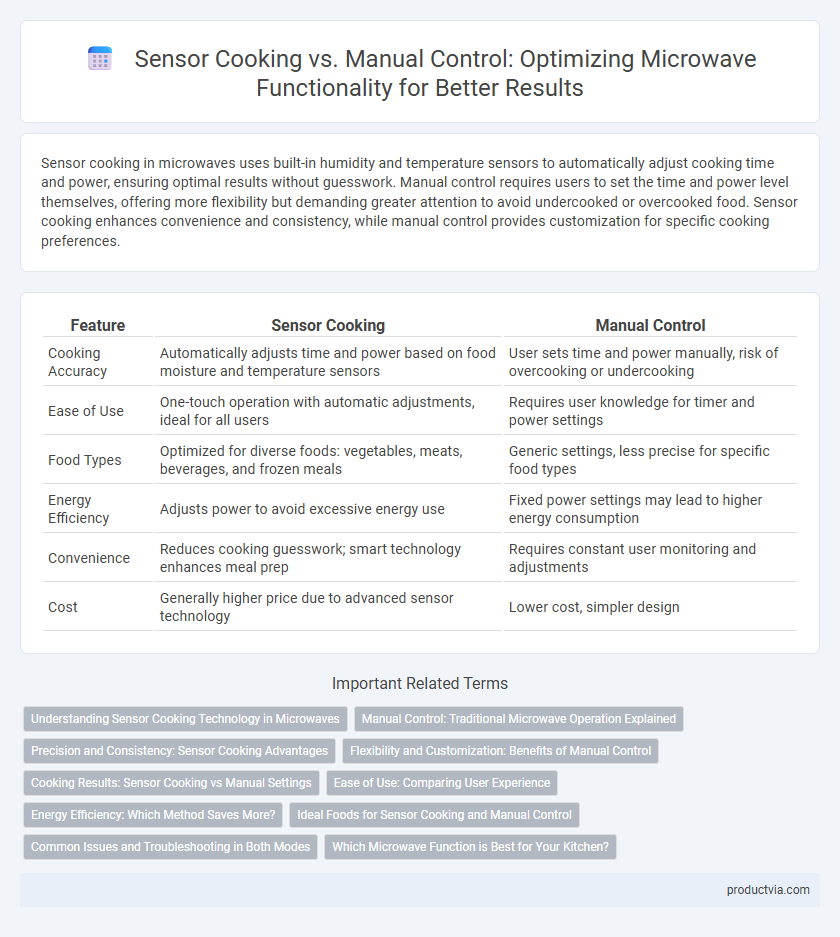Sensor cooking in microwaves uses built-in humidity and temperature sensors to automatically adjust cooking time and power, ensuring optimal results without guesswork. Manual control requires users to set the time and power level themselves, offering more flexibility but demanding greater attention to avoid undercooked or overcooked food. Sensor cooking enhances convenience and consistency, while manual control provides customization for specific cooking preferences.
Table of Comparison
| Feature | Sensor Cooking | Manual Control |
|---|---|---|
| Cooking Accuracy | Automatically adjusts time and power based on food moisture and temperature sensors | User sets time and power manually, risk of overcooking or undercooking |
| Ease of Use | One-touch operation with automatic adjustments, ideal for all users | Requires user knowledge for timer and power settings |
| Food Types | Optimized for diverse foods: vegetables, meats, beverages, and frozen meals | Generic settings, less precise for specific food types |
| Energy Efficiency | Adjusts power to avoid excessive energy use | Fixed power settings may lead to higher energy consumption |
| Convenience | Reduces cooking guesswork; smart technology enhances meal prep | Requires constant user monitoring and adjustments |
| Cost | Generally higher price due to advanced sensor technology | Lower cost, simpler design |
Understanding Sensor Cooking Technology in Microwaves
Sensor cooking technology in microwaves leverages humidity and temperature sensors to automatically adjust cooking time and power levels, ensuring optimal results without user input. This smart functionality prevents overcooking or undercooking by detecting steam emitted during cooking, allowing precise control over food doneness. Compared to manual control, sensor cooking enhances convenience and accuracy by adapting to varying food types and portion sizes dynamically.
Manual Control: Traditional Microwave Operation Explained
Manual control in microwave functionality allows users to set cooking time and power levels based on personal experience, offering precise customization for various recipes. This traditional method relies on user judgment without automated sensors, making it ideal for cooking tasks that require specific heat distribution and timing. Manual control remains popular for those seeking flexibility and control over microwave cooking parameters.
Precision and Consistency: Sensor Cooking Advantages
Sensor cooking in microwaves provides precise control by automatically detecting food moisture and adjusting cooking time accordingly, ensuring optimal results without guesswork. This technology delivers consistent heating and avoids overcooking or undercooking, unlike manual control, which relies on user estimation. Enhanced accuracy in sensor-based microwaves improves food texture and taste, making meal preparation more reliable and efficient.
Flexibility and Customization: Benefits of Manual Control
Manual control in microwaves offers superior flexibility and customization compared to sensor cooking, allowing users to adjust power levels and cooking times precisely to suit specific recipes and ingredients. This control benefits experienced cooks who require tailored heating to avoid overcooking or undercooking delicate dishes. Unlike sensor cooking, manual settings empower users to experiment and fine-tune microwave performance based on personal preference and culinary needs.
Cooking Results: Sensor Cooking vs Manual Settings
Sensor cooking in microwaves automatically adjusts cooking time and power based on the moisture and temperature detected in the food, resulting in consistently precise and evenly cooked meals. Manual control requires users to estimate cooking time and power levels, increasing the risk of undercooking or overcooking, which can affect food texture and flavor. Sensor cooking enhances convenience and accuracy, optimizing cooking results by adapting in real-time to diverse food types and quantities.
Ease of Use: Comparing User Experience
Sensor cooking in microwaves offers a superior ease of use by automatically adjusting cooking time and power based on food moisture levels, minimizing user input and guesswork. Manual control requires users to set precise cooking times and power levels, demanding more attention and experience to avoid undercooking or overcooking. The convenience of sensor cooking enhances user experience by delivering consistent results with minimal effort, making it ideal for busy households and novice cooks.
Energy Efficiency: Which Method Saves More?
Sensor cooking technology in microwaves detects moisture and humidity levels in food, automatically adjusting cooking time and power to prevent overcooking, which leads to significant energy savings compared to manual control. Manual control requires user input for time and power settings, often resulting in longer cooking cycles and unnecessary energy consumption due to guesswork. Studies show sensor cooking can reduce energy use by up to 20%, making it a more efficient method for conserving electricity during microwave operation.
Ideal Foods for Sensor Cooking and Manual Control
Sensor cooking in microwaves is ideal for reheating leftovers, cooking vegetables, and steaming fish, as the sensors automatically adjust cooking time and power based on moisture and humidity levels. Manual control is preferable for foods requiring precise time settings or specific power levels, such as defrosting meat, baking cakes, or heating beverages. Using sensor cooking for common items ensures even cooking without overcooking, while manual control offers greater flexibility for customized recipes.
Common Issues and Troubleshooting in Both Modes
Sensor cooking in microwaves often faces issues like inaccurate moisture detection leading to undercooked or overcooked food, while manual control can result in improper cooking times due to user error. Common troubleshooting for sensor cooking involves cleaning the sensor area and ensuring food placement complies with sensor specifications, whereas manual mode troubleshooting centers on calibrating power levels and verifying time settings. Both modes benefit from regular maintenance and adherence to manufacturer guidelines to optimize microwave performance and food quality.
Which Microwave Function is Best for Your Kitchen?
Sensor cooking in microwaves uses advanced humidity and temperature sensors to automatically adjust cooking time and power for optimal results, minimizing overcooking and undercooking. Manual control allows precise user customization of power levels and cooking duration, beneficial for recipes requiring specific heat application or timed intervals. Choosing between sensor cooking and manual control depends on whether you prioritize convenience and automatic adjustments or detailed cooking precision for your kitchen needs.
Sensor Cooking vs Manual Control for Microwave Functionality Infographic

 productvia.com
productvia.com